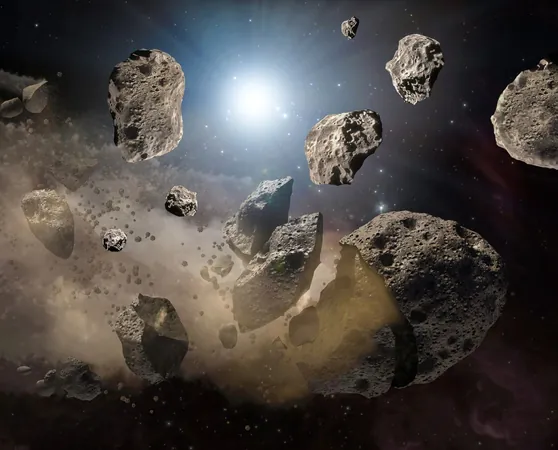
Unlocking the Secrets of Meteorites: Where Do They Really Come From?
2025-03-24
Author: Ming
Unlocking the Secrets of Meteorites: Where Do They Really Come From?
For decades, scientists have been captivated by a pressing question: what is the origin of meteorites that plummet to Earth? These celestial visitors often leave us in awe as they illuminate the night sky before crashing down, yet pinpointing their origins within the asteroid belt—a vast domain located between Mars and Jupiter—has long remained an enigma.
Recent advancements by researchers at Curtin University and the SETI Institute, in collaboration with NASA Ames Research Center, are shedding light on this mystery. This comprehensive study has successfully linked the orbits of 75 meteorites to their likely points of origin, contributing significantly to our understanding of the celestial bodies that make up our solar system's asteroid belt.
Tracking Fireballs: A Scientific Endeavor
The journey into the world of meteorites started about a decade ago, when the research team initiated an ambitious project to deploy a network of all-sky cameras across California and Nevada. These high-tech devices were designed to capture the fleeting brilliance of meteors as they burned through Earth's atmosphere. As a result of this project, and with contributions from other global fireball monitoring networks, the Global Fireball Observatory was born, enabling the tracking of numerous meteorite events.
Hadrien Devillepoix, an astronomer involved in the project, noted, "Through significant collaboration and citizen science, we have mapped the paths of 17 meteorite falls, helping to unveil the greater cosmic dance of these rocks."
Decoding Their Origin: What Meteorites Reveal
The majority of meteorites on Earth trace their roots back to the asteroid belt, which houses over a million objects larger than one kilometer. These meteorites often originated from larger parent bodies that fragmented during catastrophic collisions, leading to debris fields that scatter across space.
For instance, the study revealed that 12 iron-rich ordinary chondrite meteorites (H chondrites) have ties to a debris field known as "Koronis," located in the inner reaches of the asteroid belt. By employing a method called cosmic-ray exposure dating, scientists can determine how long a meteorite has spent in space. This technique, when combined with the age of asteroid clusters, crafts a clearer timeline of when these meteorites were ejected from their parent bodies.
By better understanding these origins, researchers identified three H chondrites linked to the Koronis cluster, which is approximately 5.8 million years old, and two more from the Koronis2 cluster, aged between 10 to 15 million years.
A Broader Cosmic Network
Interestingly, meteorites do not all originate from Koronis alone. Some exhibit steep orbits pointing to the Nele asteroid family, while others, with an exposure age around 35 million years, align with the Massalia family. The exploratory research further confirms that L chondrites and LL chondrites have their own distinct source regions, highlighting a complex web of origins that enrich our solar system narrative.
For instance, LL chondrites are primarily sourced from the Flora family, while L chondrites appear to come from the Hertha family. Notably, the Hertha asteroid bears the marks of a violent collision, which signifies a fascinating backstory for its debris.
Implications for Planetary Defense
Understanding the origins of meteorites isn't just an academic endeavor; it holds significant implications for planetary defense. By tracing the source families of meteoroids that reach Earth, scientists can better assess potential threats posed by larger bodies that may one day be on a collision course with our planet. Near-Earth Asteroids (NEAs), while not on the same orbits as meteorites themselves, often share origins with meteorites, allowing us to anticipate possible risks.
Future Directions: Expanding Our Cosmic Map
Looking ahead, astronomers aim to further enhance their monitoring of asteroids before they reach Earth. The successful observation of a small asteroid named 2008 TC3, which was tracked in space and recovered post-landing, showcases the potential for future endeavors. With advancements in observatory technologies, researchers anticipate repeating this success and filling in the gaps on their evolving asteroid belt map.
Every tracked meteorite brings us a step closer to deciphering the stories of our solar system's past while marking the path toward understanding its future. As scientists continue to unravel these cosmic mysteries, we stand on the brink of monumental discoveries that will redefine our comprehension of the universe.
Stay curious, and keep looking up!



 Brasil (PT)
Brasil (PT)
 Canada (EN)
Canada (EN)
 Chile (ES)
Chile (ES)
 Česko (CS)
Česko (CS)
 대한민국 (KO)
대한민국 (KO)
 España (ES)
España (ES)
 France (FR)
France (FR)
 Hong Kong (EN)
Hong Kong (EN)
 Italia (IT)
Italia (IT)
 日本 (JA)
日本 (JA)
 Magyarország (HU)
Magyarország (HU)
 Norge (NO)
Norge (NO)
 Polska (PL)
Polska (PL)
 Schweiz (DE)
Schweiz (DE)
 Singapore (EN)
Singapore (EN)
 Sverige (SV)
Sverige (SV)
 Suomi (FI)
Suomi (FI)
 Türkiye (TR)
Türkiye (TR)
 الإمارات العربية المتحدة (AR)
الإمارات العربية المتحدة (AR)